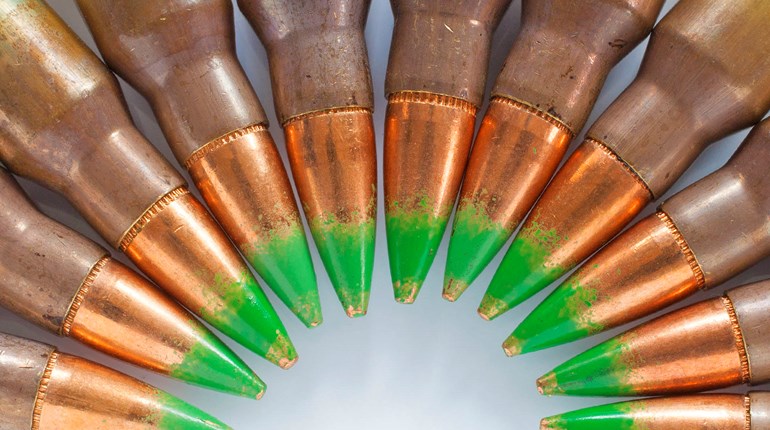
We entered Sinjar at night—ISIS rocket and mortar attacks typically happen at sunup and sundown, so a trip to the front line is safest under cover of darkness. As the battered Toyota pickup rolled through rubble-strewn streets, it was clear this ancient city, once home to 500,000 people, was now populated only by ghosts and a few soldiers huddled around fires trying to stay warm.
On my last trip to Iraq in November 2015, our “Frontlines” team was comprised of LtCol Oliver North, my intrepid cameraman Dennis Azato and me. Because North has amazing connections, we were accompanied by a top-notch security team in a convoy of armored vehicles. We toured the front with ISIS and saw Kurdish preparations underway to retake the city of Sinjar, which was completed successfully just days after we left. We interviewed Iraqi and Syrian refugees whose eyes reflected the horrors they had faced when ISIS drove them from their homes. We slept and ate and drank tea in bunkers on the front alongside Peshmerga fighters who would sit and smoke and listen to ISIS chatter on their handheld walkie-talkies.
This trip was different. An email came in from Dave Eubank, an old Army Ranger buddy who runs an aid organization called the Free Burma Rangers. Dave was in Iraq with a medical team helping the Peshmerga, and alerted me to a new horror ISIS had employed—chemical gas. As ISIS loses ground in Iraq, sources indicate they are still growing in number—by as many as 2,500 fighters every month from all over the globe.
On Feb. 11, ISIS fired more than 30 mortars and rockets filled with an unknown chemical agent into the outskirts of Sinjar, where the new front line is located. More than 175 Peshmerga troops were affected by the gas, some seriously.
When I received the news, no media reports had yet appeared on the attack. So although I lacked the official credentials or even permission to be there, I hopped the first plane I could find back to Erbil.
My plane arrived in the Kurdish capital at 2 a.m. Bahaa, an Iraqi Christian, met me at the door, and soon we were rolling through the nearly deserted streets of Erbil. The crucifix swaying from his rearview mirror gave me great comfort. With a Christian driving the taxi, the chances of me ending up in an orange jumpsuit were basically nil. ‘nuf said.
To drive directly to Sinjar used to take 2.5 hours, via Mosul. Bahaa explained that since that route is now mostly controlled by D’aesh, the local term for ISIS, we’d have to drive north to Duhok and then back southwest to Sinjar, making the trip closer to six hours. We still had to make it through the Kurdish military checkpoints, and without official permission, we approached the checkpoints with big smiles and waves as if we were long lost friends of the bored soldiers manning the barriers. Our prayers answered, they returned confused smiles and waved us through.
Iraqi government officials are asserting that ISIS has lost over half the territory it once controlled in Iraq. This is due to continued pressure by the Kurdish Peshmerga in the North, Iraqi government forces in the South and more than 100 coalition airstrikes each week.
But that doesn’t necessarily mean ISIS is about to be defeated. As ISIS loses ground in Iraq, sources indicate they are still growing in number—by as many as 2,500 fighters every month from all over the globe. It isn’t hard to imagine that as civilized countries line up to pound ISIS territory in Syria, Iraq and elsewhere, many of these fighters might return to their countries of origin—and also flee to Europe and the United States. They will be returning to a place where they won’t have to worry about bombs from the sky, and where the targets of their hatred—civilized people—are close at hand. As the attacks in Paris and Brussels have shown, and as ISIS itself has announced, this isn’t speculation—it’s already happening.
Across northern Iraq, skirmishes with Islamic State fighters continue all along the 300-kilometer front line from Baghdad to the Syrian border. ISIS is being pushed back on all fronts, but they aren’t going easily. Since the Feb. 11 chemical attack, there have been more than a dozen other chemical attacks across the front line. More than 1,000 people have been sickened and several small children have died.
The media have only sporadically reported on the chemical attacks, which is about all that can be expected in the midst of a hotly contested electoral race. But this is an extremely important issue: First, because it is eminently feasible that ISIS will transport those chemical weapons into Europe or the United States and deploy them in a crowded venue, and second because of what those weapons say about the current American president and his former secretary of state, Democratic presidential front-runner Hillary Clinton. The media has only sporadically reported on the chemical attacks, which is about all that can be expected in the midst of a hotly contested electoral race.
In August 2012, President Barack Obama was asked if he thought the Syrian government had enough controls on it’s stockpile of chemical weapons to ensure they did not fall into the wrong hands, and whether it would be worth deploying U.S. troops to the region to make sure this did not happen. He dismissed the idea as unlikely. Since that day, ISIS has overrun several major Syrian military bases, capturing whatever weapons and materials they contained. If the chemical weapons used in Iraq prove to have originated from Syrian stockpiles, it could be quite embarrassing to the Obama administration.
Recent claims that then-Secretary of State Clinton was “instrumental” in Syrian ceasefires and the destruction of their chemical weapon stockpiles mean this could be equally damaging to her run for president.
Perhaps this is one reason nobody has been allowed to come and test the chemical residue left by these attacks to determine their origins or even what kind of chemical they are. Though there are hundreds—perhaps thousands—of U.S. troops currently guarding concrete blocks at the Erbil airport in northern Iraq, so far none have ventured to the sites of these chemical attacks to determine their cause.
The Iraqi and Kurdish civilians and Peshmerga fighters suffer for this: They have very limited equipment with which to protect themselves from these types of attacks, and simply knowing what kind of gas was being used would be of immense help.
The Kurds see fighting ISIS as not just protecting their homeland, but in a larger global context—diminishing ISIS so the rest of the world won’t have to do so. And they are doing it with substandard weaponry, little training and virtually no protection from the dreaded chemical gas.
I slept on the front line south of Sinjar in a bunker alongside several Peshmerga. They seemed genuinely happy to have me there—glad someone was finally going to tell the world about their plight.
While I was there, ISIS attacked with mortars and rockets every morning and every night. The shells came sporadically, in ones and twos, fired from nearby villages that are still under ISIS control. My interpreter, a Yazidi named Shaheen, complained bitterly that the Peshmerga hadn’t pushed another two kilometers south before stopping their advance: Shaheen’s village was visible in the distance, and he claimed hundreds of his family and friends were still being held hostage there. It was physically painful, he said, to be so close and to be unable to do anything to free his family.
We went to visit the site of the Feb. 11 chemical attack. More than 30 mortars had landed in a field just east of the village, creating a vapor cloud that eventually sickened 170 men. By now most of the craters have been buried by the Peshmerga to make the area safer from the chemical residue left by the mortars. The smell was still strong of rotten vegetables, which is indicative of sulfur mustard agent like the one used to kill over 5,000 Kurds by Saddam Hussein in 1988. As we got close, it irritated our sinuses and gave us headaches. We found several craters that had not been buried, with mortar tail fins still lying around in the open.
When we returned from the site of the attack, we stopped and had lunch with a doctor who had once been a surgeon in Mosul. When ISIS took over the city, he stayed for one month, but when ISIS decapitated four men in front of his house, he fled with his family. The doctor now runs a tiny clinic for the Kurdish soldiers in an abandoned house in Dumis. He has set up a tiny three-bed ward and has treated over 100 soldiers affected by the poisonous gas. He was very distraught that nobody has come to test the substance and determine exactly what it was. He keeps a fist-sized sample of a tarlike substance that came from the bomb in triple plastic bags in his office in hopes someone will come test it.
When we returned from lunch, a soldier who had been affected by the gas came, holding a rag to his nose. Apparently the effects had been getting worse throughout the week. Before anyone could even look at him, he collapsed to the ground.
We rushed him to the Kurdish surgeon’s clinic, where he was treated with shots of adrenaline, an IV and oxygen. Doctors then put him in an ambulance and rushed him to Sinjar, then on to Duhok for more treatment.
About that time, incoming mortars started falling around our position. The Kurds began firing back with DSKS and other small arms. More firing continued, and it seemed a major firefight was about to occur until a coalition jet showed up and circled overhead. At that point, ISIS decided discretion was the better part of valor and stopped firing. Sinjar is a warning to the civilized world: This is what ISIS would do to your cities.
Once the action subsided, we drove about 20 minutes back into the center of Sinjar. An eerie stillness now covers the city like a fog. It is hard to describe the scale of destruction we found there. Miles of razed buildings, those few left standing looted and burned. It looked like the grainy photos I’ve seen of Stalingrad after WWII. Many buildings were so completely destroyed as to have no stone left upon another. I wandered through the abandoned streets for the better part of an afternoon, carefully picking my way among the ruined buildings. There are miles of tunnels dug beneath the city for ISIS by Yazidi slaves. Those I explored even more carefully. Many of them were still wired with IEDs—the cause of 70 percent of Peshmerga casualties while taking the city. It was evident by graffiti painted on each gate that ISIS had gone house to house and demolished any building that didn’t belong to a Sunni Muslim. I was struck by how much work that must have been—wiring up and detonating thousands of houses into rubble. And for what? The sheer scale of malevolence represented by all those flattened houses boggles the mind.
Just before sunset, we drove east to a tiny village—now nothing more than a handful of destroyed homes. Near the village is an unmarked grave containing the remains of the more than 90 villagers who lived there. The grave was one of dozens that have been found—this one discovered only because a woman who managed to hide and witness the massacre later led the Kurds to the site after they retook Sinjar. Human bones scatter the desiccated ground, a bullet hole in the top of each bleached skull.
I’ve seen a lot of mayhem in this job, so at first the piles of human remains, though sobering, didn’t bother me that much. But then I spotted a short, blond braid of hair lying among the skeletons, and in my mind’s eye, I saw that braid attached to my own blond daughter’s head. It was suddenly hard to breathe. A kind of rage I’ve rarely felt welled up in my chest, and at that moment I wanted nothing more than to hunt down the barbarians who have decimated so many lives in this region and to make them suffer as their victims have suffered.
Sinjar is a warning to the civilized world: This is what ISIS would do to your cities. The terrorist group must be stopped. We need rough men who are willing to hunt their toxic ideology to extinction, driven back into the dark holes from which they came. And we need leaders who will abandon the feckless foreign policy we’ve seen for the last seven years—who will call the enemy by their name, and defeat them.
I’ve heard it said that violence does not solve problems. In this case, I would have to disagree. ISIS understands nothing but violence. And violence is the language we must use to defeat them.
Before that blond braid belongs to your daughter or mine.
Watch Chuck Holton’s most recent “Frontlines” video feature, “Sinjar: After ISIS,” here.


































